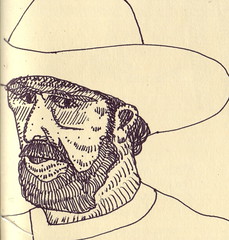Vincent van Gogh, for whom color was the chief symbol of expression, was born in Groot-Zundert, Holland, says vangoghgallery.com.
The son of a pastor, brought up in a religious and cultured atmosphere, Vincent was highly emotional and lacked self-confidence. Between 1860 and 1880, when he finally decided to become an artist, van Gogh had had two unsuitable and
unhappy romances and had worked unsuccessfully as a clerk in a bookstore, an art salesman, and a preacher in the Borinage (a dreary mining district in Belgium), where he was dismissed for overzealousness.
He remained in Belgium to study art, determined to give happiness by creating beauty. In the Belgian city of Antwerp he discovered the works of Rubens and purchased many Japanese prints.
In 1886 he went to Paris to join his brother Théo, the manager of Goupil's gallery. In Paris, van Gogh studied with Cormon, inevitably met Pissarro, Monet, and Gauguin, and began to lighten his very dark palette and to paint in the short brushstrokes of the Impressionists.
His nervous temperament made him a difficult companion and night-long drinking and discussions combined with painting all day undermined his health.
He decided to go south to Arles, France, where he hoped his friends would join him and help found a school of art.
He had moved to the town with thoughts of founding a utopian art colony, and the Danish artist Christian Mourier-Petersen (1858–1945), became his companion for two months.
Arles appeared exotic and filthy to van Gogh, says Wikipedia. In a letter he described it as a foreign country: "The Zouaves, the brothels, the adorable little Arlesiennes going to their First Communion, the priest in his surplice, who looks like a dangerous rhinocerous, the people drinking absinthe, all seem to me creatures from another world".[85]
Gauguin did join him but with disastrous results. Near the end of 1888, an incident led Gauguin to ultimately leave Arles. Van Gogh pursued him with an open razor, was stopped by Gauguin, but ended up cutting a portion of his own ear lobe off. Van Gogh then began to alternate between fits of madness and lucidity and was sent to the asylum in Saint-Remy for treatment.
In May of 1890, he seemed much better and went to live in Auvers-sur-Oise under the watchful eye of Dr. Gachet. Two months later he was dead, having shot himself "for the good of all." During his brief career he had sold one painting.
Van Gogh's finest works were produced in less than three years in a technique that grew more and more impassioned in brushstroke, in symbolic and intense color, in surface tension, and in the movement and vibration of form and line. Van Gogh's inimitable fusion of form and content is powerful; dramatic, lyrically rhythmic, imaginative, and emotional, for the artist was completely absorbed in the effort to explain either his struggle against madness or his comprehension of the spiritual essence of man and nature.
He was a prolific self-portraitist, who painted himself 37 times between 1886 and 1889. In just over a decade, he produced more than 2,100 artworks, consisting of 860 oil paintings and more than 1,300 watercolors, drawings, sketches and prints. His work included self portraits, landscapes, still lifes of flowers, portraits and paintings of cypresses, wheat fields and sunflowers.
In one of his 200 letters to his brother, Theo, he said, "Real painters do not paint things as they are...They paint them as they themselves feel them to be".
Subscribe to:
Post Comments (Atom)





No comments:
Post a Comment